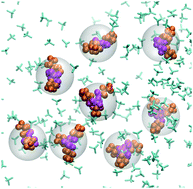Implicit-solvent coarse-grained modeling for polymer solutions via Mori-Zwanzig formalism
Abstract
We present a bottom-up coarse-graining (CG) method to establish implicit-solvent CG modeling for polymers in solution, which conserves the dynamic properties of the reference microscopic system. In particular, tens to hundreds of bonded polymer atoms (or Lennard-Jones beads) are coarse-grained as one CG particle, and the solvent degrees of freedom are eliminated. The dynamics of the CG system is governed by the generalized Langevin equation (GLE) derived via the Mori-Zwanzig formalism, by which the CG variables can be directly and rigorously linked to the microscopic dynamics generated by molecular dynamics (MD) simulations. The solvent-mediated dynamics of polymers is modeled by the non-Markovian stochastic dynamics in GLE, where the memory kernel can be computed from the MD trajectories. To circumvent the difficulty in direct evaluation of the memory term and generation of colored noise, we exploit the equivalence between the non-Markovian dynamics and Markovian dynamics in an extended space. To this end, the CG system is supplemented with auxiliary variables that are coupled linearly to the momentum and among themselves, subject to uncorrelated Gaussian white noise. A high-order time-integration scheme is used to solve the extended dynamics to further accelerate the CG simulations. To assess, validate, and demonstrate the established implicit-solvent CG modeling, we have applied it to study four different types of polymers in solution. The dynamic properties of polymers characterized by the velocity autocorrelation function, diffusion coefficient, and mean square displacement as functions of time are evaluated in both CG and MD simulations. Results show that the extended dynamics with auxiliary variables can construct arbitrarily high-order CG models to reproduce dynamic properties of the reference microscopic system and to characterize long-time dynamics of polymers in solution.



 Please wait while we load your content...
Please wait while we load your content...
